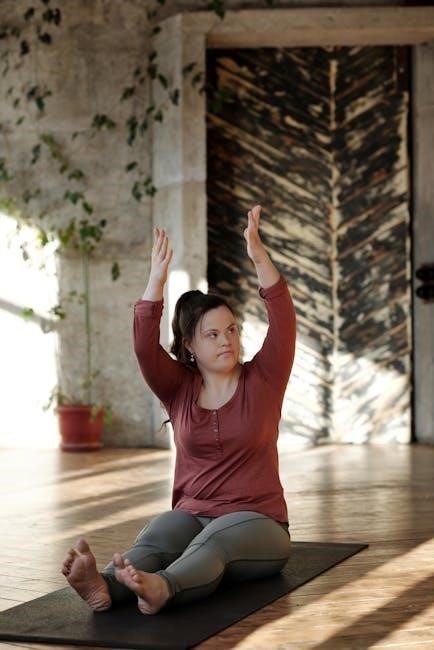iliotibial band syndrome stretches pdf
routines to alleviate symptoms effectively always online.
Overview of Iliotibial Band Syndrome
Iliotibial band syndrome is a common condition that affects the iliotibial band, a long and dense fibrous band of tissue that extends from the hip down to the lateral aspect of the knee. According to online resources, this condition is often caused by repetitive friction and irritation of the iliotibial band, leading to inflammation and pain. The iliotibial band plays a crucial role in stabilizing the knee and facilitating movement, and its dysfunction can significantly impact daily activities and athletic performance. A comprehensive understanding of the iliotibial band syndrome is essential for developing effective treatment strategies, including stretches and exercises that target the affected area. By utilizing online resources and consulting with healthcare professionals, individuals can gain a better understanding of the condition and explore available treatment options, such as physical therapy and exercise routines, to alleviate symptoms and improve overall knee function. Effective management of iliotibial band syndrome requires a thorough understanding of the condition.
Importance of Stretching in Treating IT Band Syndrome
Stretching is a crucial component in the treatment of iliotibial band syndrome, as it helps to alleviate tension and reduce inflammation in the affected area; According to online resources, stretching exercises can improve flexibility and range of motion, allowing individuals to perform daily activities and athletic endeavors with greater ease and comfort. The importance of stretching in treating iliotibial band syndrome cannot be overstated, as it enables individuals to manage their symptoms and prevent further irritation and inflammation. By incorporating stretching into their treatment regimen, individuals can experience significant improvements in their overall knee function and reduce their risk of developing chronic iliotibial band syndrome. Online resources provide a wealth of information on stretching exercises and techniques, making it easier for individuals to develop a personalized treatment plan and take control of their condition. Regular stretching can help to promote healing and prevent future episodes;

Types of Stretches for IT Band Syndrome
Various stretches, including side-leaning and hamstring stretches, are utilized to treat IT band syndrome, providing relief and improving flexibility through exercise routines always.
Iliotibial Band-Specific Stretching Regimen
An iliotibial band-specific stretching regimen is a series of exercises designed to target the IT band, providing relief from symptoms and improving flexibility. This regimen typically involves a combination of stretches, including the side-leaning stretch, which targets the IT band and surrounding muscles. The regimen may also include other exercises, such as the hamstring stretch, to help improve overall flexibility and reduce tension in the IT band. By incorporating these stretches into a regular routine, individuals can help to alleviate symptoms of IT band syndrome and improve their overall mobility. The iliotibial band-specific stretching regimen can be modified to suit individual needs and can be performed in a variety of settings, including at home or in a clinical environment, provided the individual has access to a qualified healthcare professional or physical therapist. Regular practice is essential to achieve optimal results.
Side-Leaning Stretch for IT Band Syndrome
The side-leaning stretch is a common exercise used to help alleviate symptoms of IT band syndrome, targeting the IT band and surrounding muscles. To perform this stretch, stand sideways to a wall with the injured leg towards the inside, and place the hand nearest the wall on the wall for support. Cross the uninjured leg over the injured leg, keeping the foot of the injured leg stable, and lean into the wall until a stretch is felt in the IT band. Hold the stretch for 10 seconds and repeat for 2 sets, allowing for a gentle and controlled movement. This stretch can be modified to suit individual needs, and it is essential to listen to the body and stop if any pain or discomfort is experienced. The side-leaning stretch can be performed in a variety of settings, including at home or in a clinical environment, with the guidance of a qualified healthcare professional or physical therapist.

Strengthening Exercises for IT Band Syndrome
Strengthening exercises improve flexibility and reduce symptoms using physical therapy methods always effectively online.
General Strengthening Exercises to Improve Flexibility
General strengthening exercises are essential to improve flexibility and reduce symptoms of iliotibial band syndrome. These exercises can be prescribed by a physician, physical therapist, or athletic trainer after flexibility has improved. The key is to improve the flexibility of the tissue, and general strengthening exercises can assist with other related symptoms. Exercises such as leg lifts, leg presses, and lunges can help strengthen the muscles around the knee and hip. It is also important to incorporate exercises that target the core and glutes, as these muscles play a crucial role in stabilizing the knee and hip. By incorporating these exercises into a regular routine, individuals can improve their flexibility and reduce their risk of iliotibial band syndrome. A physical therapist can help develop a personalized exercise program to improve flexibility and reduce symptoms. Regular exercise can help improve overall health and reduce symptoms.
Isometric Quad Exercises for IT Band Syndrome
Isometric quad exercises are a type of strengthening exercise that can help alleviate symptoms of iliotibial band syndrome. These exercises involve contracting the quadriceps muscles without moving the knee joint, which can help improve strength and stability. To perform an isometric quad exercise, sit on the floor with the affected leg straight out in front of you, then tighten the quadriceps muscles and hold for a few seconds. This can be repeated several times a day, and can be modified to suit different fitness levels. A physical therapist can provide guidance on how to perform these exercises correctly and safely. Isometric quad exercises can be an effective way to improve quad strength and reduce symptoms of iliotibial band syndrome, and can be incorporated into a regular exercise routine. Regular exercise can help improve overall health and reduce symptoms of iliotibial band syndrome.

Protocol for IT Band Syndrome Treatment
Treatment protocol involves frequency and goal-oriented approaches always online effectively.
Frequency and Goal of IT Band Syndrome Treatment
The frequency and goal of treatment are crucial in managing the condition, with patients aiming to gradually increase the repetition and frequency of exercises. A treatment plan typically involves a combination of stretching and strengthening exercises, with the goal of improving flexibility and reducing pain. The frequency of treatment sessions may vary depending on the severity of the condition, but most patients can expect to undergo treatment several times a week. The goal of treatment is to enable patients to return to their normal activities without experiencing pain or discomfort, and to prevent future episodes of the condition. By following a structured treatment plan, patients can effectively manage their symptoms and achieve their goals. Treatment plans are often tailored to individual needs, and may involve a range of exercises and stretches to improve flexibility and strength.
Background and Description of IT Band Syndrome
The IT band is a long, dense, fibrous band of tissue that extends from the hip down to the lateral aspect of the knee. It plays a crucial role in stabilizing the knee and facilitating movement. The condition occurs when the IT band becomes inflamed or irritated, causing pain and discomfort on the outside of the knee. This can be due to various factors, including overuse, poor training habits, or biomechanical issues. Understanding the background and description of IT band syndrome is essential in developing effective treatment plans. The condition is common among athletes and individuals who engage in repetitive knee-bending activities. A comprehensive description of IT band syndrome includes its symptoms, causes, and risk factors, which are essential in providing accurate diagnoses and treatments. By understanding the condition, healthcare professionals can develop targeted treatment plans to alleviate symptoms and promote recovery.

Additional Exercises for IT Band Syndrome
Exercises like hamstring wall stretches and hip flexor stretches are beneficial for treating the condition using online resources always.
Hamstring Wall Stretch for IT Band Syndrome
The hamstring wall stretch is a useful exercise for treating IT band syndrome, it involves lying on the back in a doorway with the good leg through the open door, then sliding the affected leg up the wall to straighten the knee, this stretch should be felt down the back of the leg. The patient should not arch their back or bend either knee during the exercise. This stretch can be modified to suit individual needs and can be done several times a day. It is essential to consult a healthcare professional before starting any new exercise routine, especially if you have a pre-existing condition. The hamstring wall stretch can be done in conjunction with other exercises, such as hip flexor stretches, to help alleviate symptoms of IT band syndrome. Regular exercise and stretching can help improve flexibility and reduce pain.